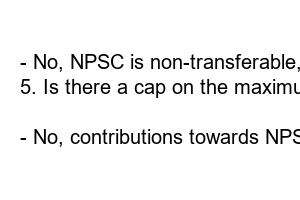국민연금 가입증명서
Title: National Pension Subscription Certificate: A Secure Retirement Solution
Introduction:
Planning for retirement is an essential aspect of financial management. The National Pension Subscription Certificate (NPSC) offers a remarkable opportunity for individuals to secure their future through a state-sponsored pension plan. In this blog post, we will delve into the details of this scheme, highlighting its key features, benefits, and how you can obtain it.
1. What is the National Pension Subscription Certificate?
The NPSC is a valuable certificate offered by the government, allowing individuals to contribute towards a pension scheme and ensure a stable income after retirement. It is specifically designed to provide financial security and peace of mind during your golden years.
2. Features and Benefits of NPSC:
With NPSC, you can enjoy numerous advantages such as:
– *Tax Benefits*: Contributions made towards the scheme are eligible for tax deductions, thus reducing your overall tax liability.
– *Flexible Contribution Options*: You can choose the amount and frequency of your contributions, enabling you to plan according to your financial capacity.
– *Safe and Secure*: The scheme is backed by the government, ensuring the safety of funds and minimizing investment risks.
– *Regular Income*: Upon retirement, you receive a guaranteed monthly pension, offering a stable income source.
– *Option to Nominate*: NPSC allows you to nominate a beneficiary who will be entitled to receive the pension in case of your unfortunate demise.
3. How to Obtain an NPSC?
To acquire an NPSC, follow these simple steps:
– Visit the official website of the designated pension authority.
– Fill out the required application form with accurate personal details.
– Submit the required documents as per the guidelines specified.
– Make the initial contribution to activate your NPSC.
4. Who is Eligible for NPSC?
Any Indian citizen, regardless of their employment status, is eligible to apply for an NPSC. Both employed individuals and self-employed professionals can benefit from this scheme.
5. Are There Any Withdrawal Rules?
Unlike some other retirement plans, the withdrawal rules for NPSC are strictly regulated. Generally, you cannot access the funds before the age of 60. However, certain exceptional circumstances, such as critical illness, may permit pre-mature withdrawal under specific conditions.
6. Is NPSC Suitable for Everyone?
While NPSC is an advantageous pension scheme, it is essential to consider your financial goals, risk tolerance, and retirement needs before opting for it. Consulting with a financial advisor can help determine if NPSC aligns with your specific requirements.
Summary:
The National Pension Subscription Certificate (NPSC) is a practical and reliable retirement solution offered by the Indian government. With its flexible contribution options, tax benefits, and guaranteed income after retirement, NPSC provides individuals with a sense of financial security. If you are looking to safeguard your future and secure a steady income stream during retirement, NPSC is worth exploring.
FAQs:
1. What is the minimum age requirement to apply for an NPSC?
– The minimum age requirement to apply for an NPSC is 18 years.
2. Can I increase or decrease my NPSC contributions in the future?
– Yes, you have the flexibility to adjust your contributions according to your changing financial circumstances.
3. What happens to my NPSC if I change jobs?
– Your NPSC is not affected by changing jobs; it remains intact and continues to accumulate funds until your retirement.
4. Can I transfer my NPSC to another person?
– No, NPSC is non-transferable, as it is linked to your individual pension account.
5. Is there a cap on the maximum contribution towards NPSC?
– No, there is no upper limit on the maximum contribution, allowing you to accumulate a substantial pension fund.
6. Can I continue contributing to NPSC after the age of 60?
– No, contributions towards NPSC are not allowed after the age of 60. However, the accumulated funds will continue to grow until retirement.

